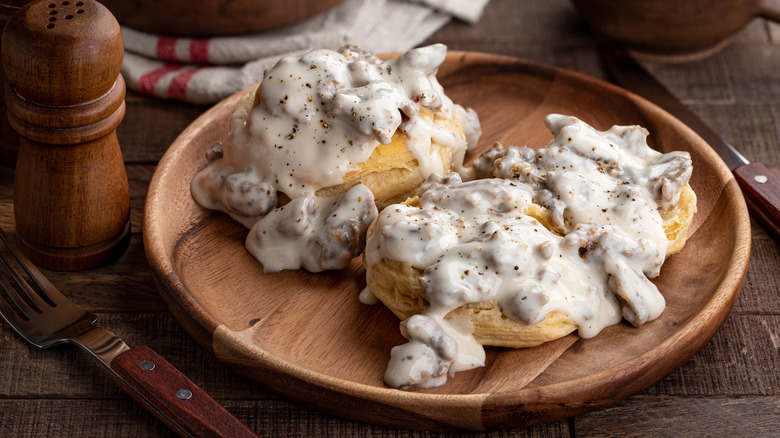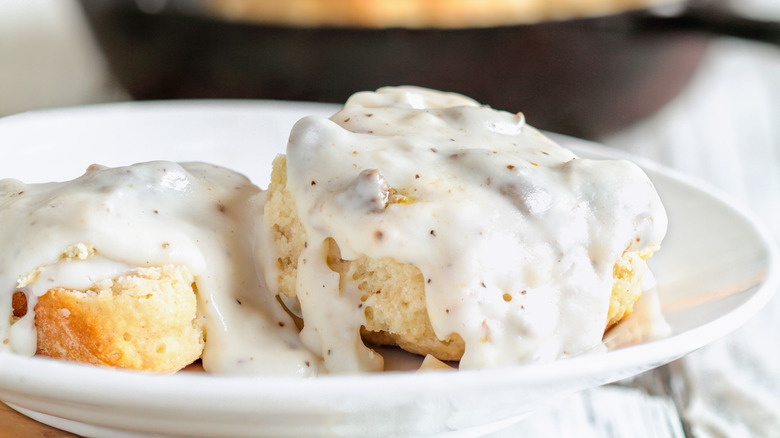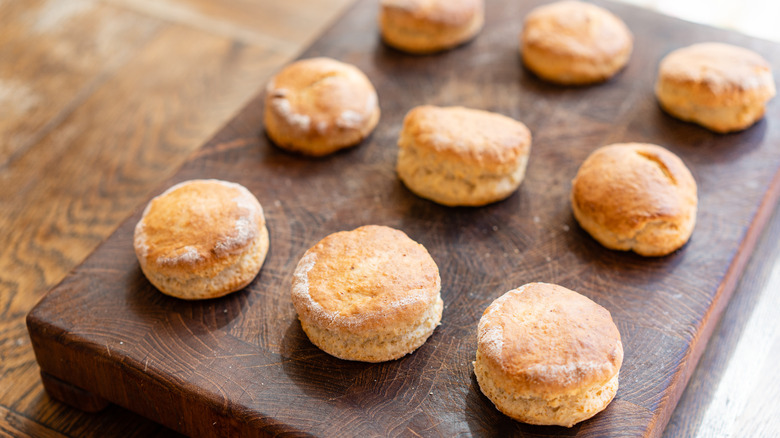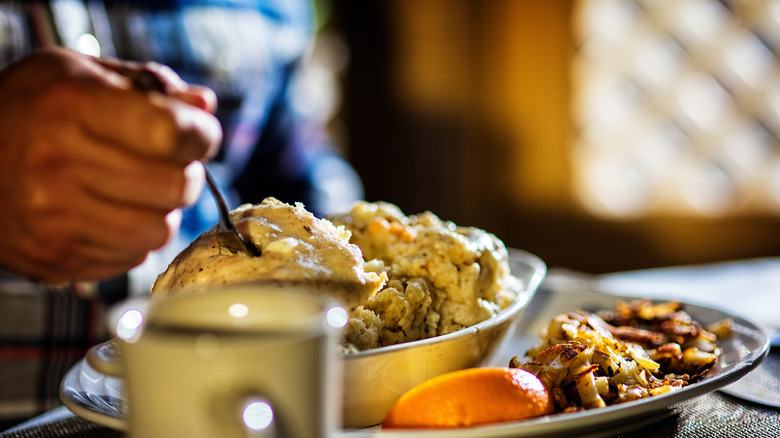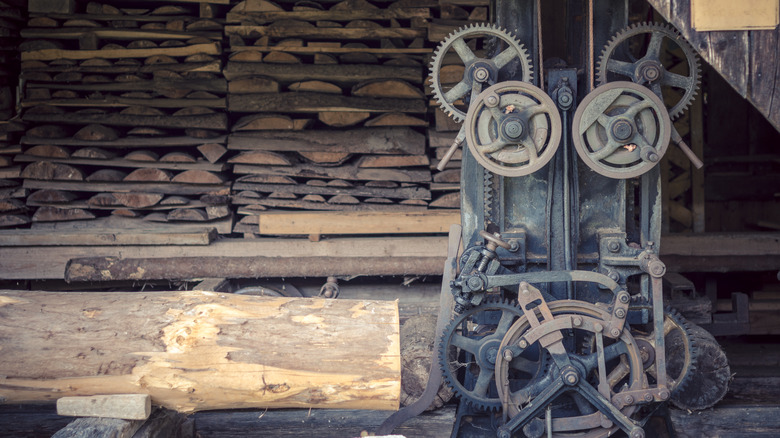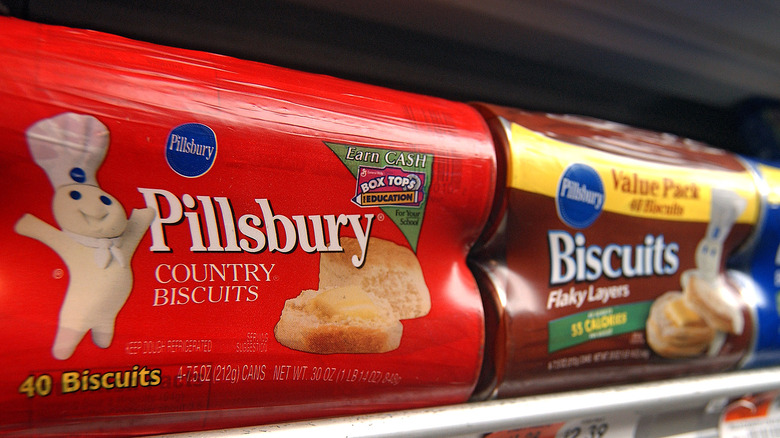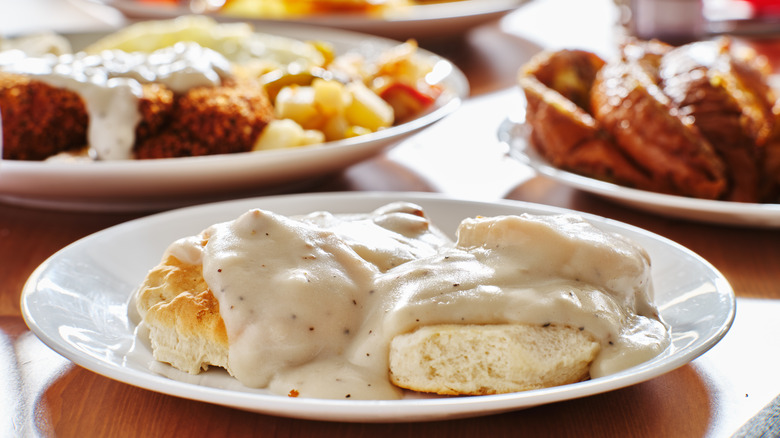Biscuits And Gravy: 6 Things You Might Not Know About The Southern Staple
A quintessential Southern staple, biscuits and gravy are a hearty comfort food with deep roots in the American South. One of the hallmarks of Southern cooking is its appreciation for soulful, made-with-love dishes that bring families and communities together. Biscuits and gravy are no exception. The beloved dish marries two simple yet sublime components: tender, flaky biscuits and a creamy, savory sausage gravy. It all started when resourceful cooks in rural kitchens cleverly combined humble ingredients to create a satisfying meal, proving that you can turn the ordinary into something extraordinary.
Biscuits and gravy aren't just a testament to Southern folks' knack for making magic in the kitchen with whatever's on hand; they also represent the South's long-standing tradition of heartwarming comfort food. Enjoyed at breakfast, brunch, or even dinner, biscuits and gravy is a versatile dish that can be served on almost any occasion. Here, we'll dive into the rich history and some interesting facts about the timeless dish.
1. Biscuits and gravy have always been from the South
It's challenging to pinpoint an exact date of the origins of biscuits and gravy. Some believe the dish emerged during the 1800s in the lumber mills of the Southern Appalachian, warranting the name of sawmill gravy. Others claim it was even earlier, during the Revolutionary War in the late 18th century, well before the 1800s, but still within the Southern Appalachian region. Encompassing parts of present-day states like North Carolina, Tennessee, and Kentucky, the Southern Appalachian region was populated by early American settlers who brought their culinary traditions with them, which often consisted of convenient cooking methods like Dutch ovens or cooking over the campfire.
Biscuits can be traced back to 16th-century Britain — well, technically Scotland — when large swaths of griddle-cooked unsweetened oat and barley dough were cut into pieces. But, if you ask a British person today about American biscuits and gravy, they're likely to scrunch their nose at the thought, finding it to be strange. It seems that the dish is now intrinsically American. When they were first made in the South, the dish evolved to incorporate locally available ingredients. During the Revolutionary War era and the westward expansion that followed biscuits and gravy became a staple among pioneers and frontiersmen.
2. Biscuits used to be as hard as rocks
When we think of Southern-style biscuits, we think: soft, warm, fluffy, and melt-in-your-mouth. But, the first biscuits weren't flaky and fluffy like we know them to be today. Before they reached their peak form, biscuits were brittle, dry, and tough — much more like crackers than anything else.
A big difference between the bread of the past and that of the present comes down to ingredients. Originally, they were unleavened, meaning they didn't contain any yeast or baking powder, which is essential for creating the light and airy texture of modern biscuits. Instead, these early biscuits were typically crafted from a blend of flour, water, and occasionally salt. They were prepared by folding and beating the dough, and became known as "beaten biscuits."
Moreover, milk — which can help keep bready bakes soft — was not a common ingredient to have back in the day. When the Revolutionary War began, milk was rationed. The soldiers of the Continental Army received just a pint of milk daily, and because it spoiled quickly, it was often used for drinking. So, water without yeast was used. Finally, around the late 1800s, a machine was invented that helped with leavening the "beaten biscuits." Then baking soda and powder came around, which allowed for the evolution of the leavened biscuit, and resembled the ones we know today.
3. It was a dish meant for sustenance and affordability
Biscuits and gravy's popularity stemmed from its simplicity, affordability, and its remarkable ability to satiate hunger with minimal resources. What it didn't do was herald praise for its deliciousness. To be honest, the first biscuits were bland. The ingredients were cheap, so poorer families would make a lot of it with very little money required. Remember, milk was a rarity among soldiers in the war and at home, so if they had it, they typically drank it or used it to make cheese — anything to extend its shelf-life. Water, flour, cornmeal, and salt; however, were more commonly on hand.
Pork was always considered a cheaper meat, so sausage gravy was a more feasible option. If flavor came from anywhere, it was from the drippings-based gravy. As we know today, homemade gravy made with the fond leftover in the pan is packed with flavor. Fatty and greasy as pork is, it made a decent roux as a base for "country-style" gravy. Even with milk coming in daily rations, home cooks could whisk in a little water alongside it to create a creamy texture. Not quite as thick and flavorful as the gravy we're used to today, but it worked. More than that, it kept workers full, and that was its main purpose.
4. Sawmill gravy was designed for mill workers
During the late 19th and early 20th centuries, Southern Appalachia was a hub for the timber industry. Lumber yards and sawmills were prominent employers in this region, drawing a substantial labor force. Workers in these industries often faced physically demanding and grueling jobs, particularly in the harsh conditions of the mountainous terrain. Given the demanding nature of their work, they required meals that were not only hearty and filling but also affordable.
This is where sawmill gravy came into play. It's also why many believe the recipe stemmed from this region; in particular, these workers. As the meal was made for sawmill workers, it makes sense that they could've been the first to come up with the dish. If not the biscuits, then certainly the infamous gravy. Today, sawmill gravy isn't made primarily for mill workers, and it was never made literally at the mills, either. But the name stuck, and it's still used today as a regional gravy style, even at a favorite breakfast spot like Cracker Barrel. It all comes down to how it's made. Back in the day, sawmill gravy was made with either cornmeal or flour, the fatty drippings of sausage, or sometimes other cuts of pork like bacon, and a touch of water or milk, depending on what they had on hand.
5. Pillsbury boosted the popularity of canned biscuits
Pillsbury, a brand known in most homes today, has a long history that goes back to 1869. In the 1930s, Pillsbury launched refrigerated dough products, which included their infamous canned biscuits. Before they were canned though, biscuits were primarily homemade or bakery foods. As they evolved from the water-and-flour-based biscuits, traditional Southern biscuits were still made from scratch, but with ingredients like flour, buttermilk, and lard or shortening, mixed and kneaded by hand.
It seems lucky that Southern biscuits endured through their rougher years (literally — since they were rock-hard) because as Pillsbury's canned biscuits quickly gained popularity, they played a huge role in shaping home cooking. By offering a time-saving solution without sacrificing flavor, they gave home cooks a way to keep their classic recipe going. As we know today, Pillsbury canned biscuits are convenient as well as light and airy — much more like the biscuits we're accustomed to, even if they aren't hand-mixed.
6. Biscuits and gravy are still a popular breakfast food
Right away, biscuits and gravy became a common breakfast meal because it was so easy and cheap to make, with ingredients that were locally available. From kitchens to mill workers to early restaurants, biscuits and gravy certainly made their mark. The traditional meal has endured over the years and has expanded well beyond the South. Although the recipe has changed, gaining more flavor as ingredients became more available, the concept has always remained the same. Now, you can find anything from spicy biscuits and gravy to cheesy biscuits and gravy casseroles.
Today, you can find biscuits and gravy on the menu of countless breakfast and brunch spots, diners, and cafes across the United States. Its widespread availability and delicious appeal solidify its status as a comforting, satisfying, and affordable breakfast choice that continues to delight taste buds and fill hungry stomachs.
